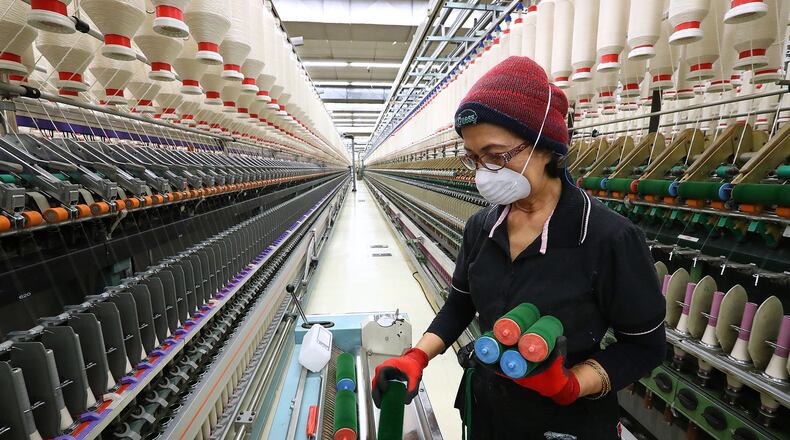Machines dreamed up in a one-story industrial building on Atlanta’s gentrifying Westside will soon begin churning out more than a million T-shirts yearly on American soil.
Up to 24 Sewbots, as they are called, will each spit out a shirt untouched by human hands about every 30 seconds in a new factory.
The fully automated assembly line is a closely watched advance in the U.S. textile industry, taking the final step of turning workers into tenders of a machine that makes the complete product.
Occasional series: How tech is changing the workforce
Rapid technological change is remaking just about every job as automation and artificial intelligence increasingly do the work of humans. The AJC is writing a series of in-depth articles about changes at the workplace and what they mean for Georgians.
It turns out the U.S. holds advantages for Suzhou Tian Yuan Garments Co, the Chinese owner of the new Arkansas plant: cheap reliable power, proximity to cotton and deep-pocketed consumers, and American-made robots that can compete with low-cost foreign labor.
Automation and artificial intelligence are revolutionizing the American workplace as machines perform tasks once unique to humans. The changes are affecting everything from picking goods off warehouse shelves to customer service calls to balancing a company's ledgers. That is also forcing schools and colleges to rethink how they train — and quickly retrain — future workers and those whose jobs become obsolete.
Over the coming months, The Atlanta Journal-Constitution will examine these workplace changes across industries and the challenges and opportunities they pose for residents of metro Atlanta and Georgia.
Politicians and economists have warned for more than 100 years that machines would put millions out of work. A 2017 National Bureau of Economic Research study projects industrial robots will have a significant negative effect on jobs and wages.
» FLASHBACK PHOTOS | Historic pictures of Georgia's textile mills
» MORE | How to stay employed in a robot world
Others believe machines will lift up workers. A 2018 report from the World Economic Forum argues automation can create a virtuous cycle in which machines take on manual or dangerous jobs, creating new and more-rewarding jobs for people.
The pace of change is accelerating. The International Federation of Robotics estimates global growth of industrial robots at 14 percent annually between 2017 and 2020. China was the biggest buyer in the first nine months of 2018. The U.S. was fourth, buying 28,158 industrial robots valued at $1.39 billion.
Credit: AJC file
Credit: AJC file
Fully automated sewing could breathe some life into the South's garment industry, decimated in recent decades as companies moved production to cheaper workers in Asia and Latin America. But it will look a lot different than before.
The Little Rock plant, opening later this year, will employ 400 people. That’s far fewer than a plant of that capacity would have employed 25 years ago. The required skills and training also have changed. Many of the positions are for technicians with coding and electro-mechanical knowledge. Even the seamstresses, who will help make clothes other than T-shirts, were put through a rigorous screening of 70 hours of unpaid classwork under observation before being considered for hiring.
Palaniswamy “Raj” Rajan, the chief executive of Atlanta-based SoftWear Automation, which designed the Sewbots, said new textile jobs will require more brain, less back. “We want people who can work with robots,” he said. “That is where the new economy comes in.”
The Sewbot idea was spun out of federally funded research done more than a decade ago at Georgia Tech. The government was interested because military equipment, including uniforms, must be U.S made.
Textiles powered Georgia’s economy, then fell off cliff
Textiles drove Georgia’s early economic development in Antebellum years. Early entrepreneurs saw the region’s expansive, slave-worked cotton fields and recognized an opportunity to mill the fiber here rather than ship it to New England for processing. After the Civil War, reestablished cotton mills helped Georgia’s economy recover. As the nation prospered, demand for everything from socks to shirts surged, bringing more jobs to the South.
In its 1950s heyday, Georgia textiles employed nearly one of every three industrial workers. As production moved outside the U.S. in subsequent decades, though, textiles shed more American jobs than any other industry. There were about 2.5 million U.S. textile workers in the early 1970s; the number plummeted to less than half a million by 2017.
Credit: AJC file
Credit: AJC file
Debra Renfroe and her family grew up in a town built by its multiple mills, Thomaston, about 60 miles south of Atlanta.
Her parents worked for one, Thomaston Mills, the county’s largest employer, and she and her brothers followed. On graduating high school in 1977, she worked in a spinning room, but a couple of years in, new machines made her job superfluous. The company moved her to folding sheets. When that job was automated, she moved again. Then in 2001, Thomaston Mills, which had shrunk over 20 years from about 3,100 workers to 1,700, declared bankruptcy and closed.
Her parents retired. Renfroe and her brothers survived mostly by getting more education, the community and state pitching in to retrain the town’s workforce and recruit new industries. One brother got a degree in accounting; another went into electrical work. The third works at a Caterpillar plant in Griffin. Renfroe first took a manufacturing job in another town, but a two-year management degree she earned while at Thomaston Mills gave her an edge. She now works as a supervisor 67 miles from home at the Kia auto plant in West Point.
“I’ve always been able to bounce back,” she said.
Credit: AJC file
Credit: AJC file
Workers today — and moreso those of tomorrow — should get used to reskilling more frequently to match the changing demands of business and work, those in workforce development say.
Upson County lost population it never regained, though it has some successes. New employers included a large commercial printer and some plastics-forming companies, along with a piano maker that lasted about 25 years before also moving overseas. And new, smaller textile companies moved into the empty mill space. But they employ hundreds rather than thousands.
» RELATED | Immigrants play essential role in textile industry
» FROM 2017 | Down on the farm: Cotton production plummets
Automation shrank the number of Georgia’s textile jobs, but it’s also the reason the industry didn’t disappear. Companies sank money into machines that don’t need weekly paychecks or benefits to operate 24/7. Textiles stabilized and even bounced back a bit recently, with companies hiring more people than they laid off some years.
Trade publications tout startups like the 11 textile factories opened in Georgia, South and North Carolina between 2013 and 2016, making everything from high-tech yarns to elements of disposable diapers. One new North Carolina plant created 500 jobs, though the same company later closed an older plant, laying off about 90.
“Speed and automation is the key” to staying competitive, said Marty Moran, the CEO of Buhler Yarns and the chairman of the trade organization the National Council for Textile Organizations.
At the Buhler Yarns plant in Jefferson, near Athens, 155 workers keep a machine-packed, four-acre yarn spinning plant running around the clock. Debris-flecked cotton comes in one end. Out the other goes cream-colored specialized yarns, shipped to the U.S. and Central America to be turned into high-end cloth. Employees who tend the machines that blend, comb and spin cotton are widely spread on the polished, concrete factory floor.
Moran estimated that it would take 15 to 20 more workers to produce the same amount in a less-automated mill. Machines newer than his are even more efficient.
“I’ve seen mills where robots will pack the yarn,” Moran said. “Where I use four people, they might have one.”
Each generation of new machinery does two things. It shaves off workers, and it makes new demands on those who remain and operate the equipment.
Moran said he tries to fill more skilled positions by spotting motivated workers and training them, whether in a technical or management field. During The Atlanta Journal-Constitution’s visit, a former machine operator worked at the elbow of a technician in the quality control lab, learning a new job.
About 20 percent of Buhler’s jobs need people with more training than a high-school education, though the industry might be closer to 30 percent, Moran said.
Atlanta startup’s next assignment: jeans and dress shirts
The new T-shirt plant powered by Atlanta-based SoftWear Automation’s Sewbots is trying to take the textile industry to another level.
Full automation for sewing clothes is difficult because cloth is not like the hard parts robots in the auto industry can easily manipulate. Manipulating soft fabric involves more complex movements and pressures and calls for moment-by-moment adjustments. Ten fingers connected to a human mind can make those adjustments. Robots, no so much, until now.
Sewbots use the evolving technologies of artificial intelligence and machine vision, with computer-driven cameras recognizing and mapping anomalies in a digitized image of cloth being sewn. Software-driven algorithms can adjust or stop a machine. Working on a metal and plastic surface, Sewbots flatten pieces of pre-cut cloth with vacuums. Precisely controlled pincers, rollers and arms move the pieces along a lineup of sewing machines that stitch one particular seam before moving the T-shirt-to-be through 11 or more other steps.
SoftWear Automation said a machine-made shirt can cost less than $3 to produce, competitive with China’s workers. It declined to say how much its Sewbots cost, but the state of Arkansas said TY Garments, the subsidiary of Suzhou Tian Yuan, would spend $20 million outfitting the building. TY Garments did not respond to requests for interviews.
Rajan, the CEO of the company making the Sewbots, said a person who is comfortable using an iPhone interface can be trained to operate a Sewbot. But teams of technicians will keep them running. Robotics will “create a whole new class” of higher-paid workers, he predicted.
In five years, Rajan hopes Sewbots make 25 percent of the four billion T-shirts sold yearly in the U.S. Only about 2 percent sold in the U.S. are made here today, according to one estimate.
His plans don’t stop at T-shirts. Rajan believes SoftWear Automation in the next five years will master the 70 or more steps for machine-made jeans and dress shirts. Add it up, and he thinks a robot-driven garment industry could add 50,000 to 100,000 U.S. jobs over the next decade.
Greg Vessels, a University of Georgia professor and textile expert, calls Rajan’s sales goals “quite optimistic.’’ Even if that happens, the level of employment in the textile industry would still be only 5 percent to 10 percent of what it used to be, he added.
Still, he sees an opening.
“Most companies will probably use a blended strategy, continuing to offshore products that make sense, but turning to America-made where it makes sense for customers looking for the latest look or piece of clothing,” said Vessels.
About the Author
Keep Reading
The Latest
Featured











